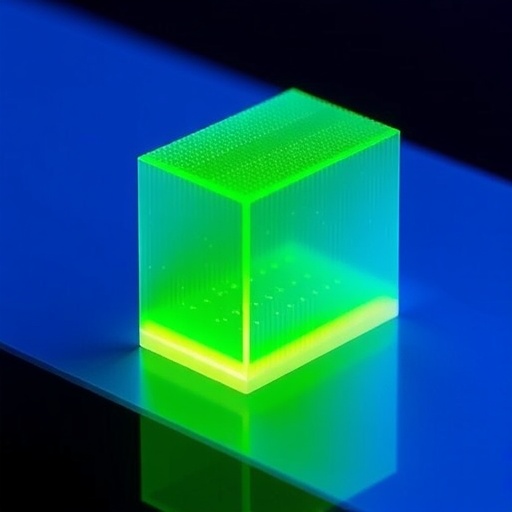In an impressive breakthrough in the realm of material science, researchers Rajesh Verma and Rahul Gupta have unveiled a novel flexible generator that employs holmium-doped zinc oxide (ZnO) and polyvinylidene fluoride-co-hexafluoropropylene (PVDF-HFP) composite films. This innovative technology promises significant advancements in the development of piezoelectric sensors, which are crucial in a multitude of applications including wearable electronics, medical devices, and environmental monitoring systems. The study, poised for publication in the 2025 edition of the journal Ionics, emphasizes the potential of this composite material to revolutionize how energy is harnessed from mechanical vibrations.
The importance of piezoelectric materials can’t be overstated, as they convert mechanical energy into electrical energy, creating opportunities for various applications in renewable energy and smart technology. The research conducted by Verma and Gupta focuses on enhancing the efficiency and flexibility of these materials, addressing the limitations of conventional piezoelectric sensors. This flexible generator offers a compelling solution to the traditional rigidity associated with earlier technologies. By infusing Holmium, a rare earth metal, into the ZnO matrix, the researchers aimed to unlock enhanced piezoelectric properties and flexibility that can be easily integrated into modern technological devices.
One of the key objectives of the research was to overcome challenges related to the mechanical fragility and temperature sensitivity that often plague traditional piezoelectric materials. The incorporation of ho-doping into the ZnO structure has shown remarkable promise, yielding a composite film that not only retains remarkable flexibility but also exhibits improved piezoelectric response. This characteristic is vital for applications where flexibility is paramount, such as in wearables that must conform to the body’s movements without sacrificing performance.
Characterizing the materials used in this study, PVDF-HFP has long been recognized for its excellent piezoelectric properties and processability. By combining PVDF-HFP with holmium-doped ZnO, the researchers were able to enhance the energy conversion capabilities of the composite film. The resultant material exhibits a significant increase in piezoelectric coefficient, which is a measure of the material’s ability to generate electrical charge when subjected to mechanical stress. This improvement opens up a wealth of possibilities in harnessing energy from everyday activities, enabling the generation of power from motion that can be utilized in various electronic devices.
The fabrication process of the holmium-doped ZnO/PVDF-HFP composite films involved a meticulous approach that ensured optimal integration of the three components. The researchers employed techniques such as solution casting and ultra-sonication to achieve uniform dispersion of holmium ions within the ZnO lattice. This meticulous synthesis process is crucial; it not only improves the mechanical properties of the composite but also enhances its overall piezoelectric performance. As highlighted in the study, achieving a homogenous distribution of dopants is vital for maximizing the functional characteristics of the resulting films.
Through comprehensive electrical characterization, Verma and Gupta demonstrated that their generator exhibits a superior voltage output under mechanical strain, which is a critical factor for its application in piezoelectric sensors. The remarkably high output power achieved with this new composite film surpasses many conventional piezoelectric materials on the market today. This finding underscores the potential for integrating this technology into future devices that demand both efficiency and flexibility.
Adopting this innovative generator technology opens up various promising applications that can transcend traditional boundaries. For instance, the research points to potential integration in autonomous systems and the burgeoning field of wearable technology. The adaptability and lightweight nature of the flexible generator make it an ideal candidate for powering small electronic devices, leading to enhanced portability and user comfort. The shift towards self-powering devices demonstrates a significant evolution in how we think about energy sources in the face of growing sustainability concerns.
Moreover, the implications of this research extend to medical fields, particularly in the development of biosensors that require durable and reliable power sources. Medical devices often face challenges in terms of power supply and on-body operability. With this new flexible generator, there lies potential for innovative solutions that can lead to advancements in health monitoring, drug delivery systems, and prosthetics that can harvest energy from motion, ultimately leading to improved patient outcomes.
As the journey of Rajesh Verma and Rahul Gupta continues in refining this technology, the prospects of commercial viability come into play. The partnership between academic research and industry needs to foster pathways for translating laboratory discoveries into market-ready solutions. This collaboration is essential for catalyzing breakthrough innovations that can meet real-world demands while also addressing the global call for sustainable technologies.
In conclusion, the findings put forth by this research team might just be the cornerstone needed to pave the way for a new generation of piezoelectric materials. With the combined properties of flexibility, efficiency, and adaptability, holmium-doped ZnO/PVDF-HFP composite films stand as a testament to the remarkable possibilities that lie within the intersection of material science and technological innovation. This pioneering work not only sets a new benchmark in piezoelectric sensor design but also encourages further exploration into doping methods and composite materials that could enhance energy harvesting technologies.
As the research awaits its publication in Ionics, the scientific community watches closely, anticipating the ripple effects of this groundbreaking work that will undoubtedly inspire future innovations in the energy sector.
Subject of Research: Flexible generator based on Ho-doped ZnO/PVDF-HFP composite films
Article Title: Flexible generator based on Ho-doped ZnO/PVDF-HFP composite films for piezoelectric sensors.
Article References:
Verma, R., Gupta, R. Flexible generator based on Ho-doped ZnO/PVDF-HFP composite films for piezoelectric sensors. Ionics (2025). https://doi.org/10.1007/s11581-025-06817-w
Image Credits: AI Generated
DOI: 08 November 2025
Keywords: Piezoelectric sensors, Holmium-doped ZnO, PVDF-HFP, Composite films, Flexibility, Energy harvesting, Wearable technology, Medical devices, Renewable energy.
Tags: advanced material science breakthroughsenergy harvesting technologyenhancing piezoelectric efficiencyenvironmental monitoring systemsflexible piezoelectric sensorsholmium-doped zinc oxidemechanical to electrical energy conversionovercoming piezoelectric limitationsPVDF-HFP composite filmsrenewable energy innovationssmart technology integrationwearable electronics applications





